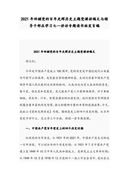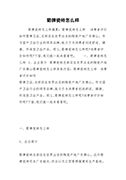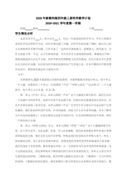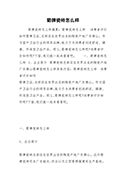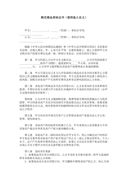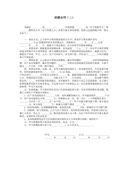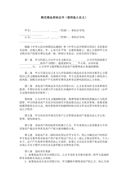Unit 17 Nature(精选3篇)高一英语教案
Unit 17 Nature(精选3篇)
Unit 17 Nature 篇1
教学目标
知识目标:
通过本单元的教学,使学生了解并初步掌握现在进行时被动语态的用法。复习本单元出的表示打算和目的的用语。学习课文能应用所学语言描述麋鹿的今昔对比,使学生了解保护野生动物的意义。
教学重点与难点
1.重点词汇 increase; disappear; alive; research; protect; put on performances; at present; one after another
2.重要句型 1) How long will it take you to complete the trip? 2) We want to give some money to this project so that the number of these deer in China can be increased. 3) It is hoped that one day they will have enough animals to set them free and let them live in the wild again.
3.语法 理解并初步掌握现在进行时被动语态的用法:1) The life of the milu is being studied at present. 2) More milu deer are being moved to a new large nature park in Shishou in Hubei Province.
4.日常交际用语 打算和目的 (Intentions and purposes) : 1) Why are you making this journey? 2) We are trying to collect the money for a wildlife project. 3) We want to . . . so that . . . 4) What is the purpose of your new project? 5) That sounds a good idea. 6) Good luck with your trip!
能力目标:
1. 掌握有关的的旅行目标用语:如旅行的目的地、出发地、及旅行的目的、方式等。
2. 运用关键词汇复述课文。
3. 如何运用现在进行时的被动语态。
德育目标
让学生了解麋鹿这种动物的历史、生态环境及在我国的现状、激发学生对学习有关野生动、植物的兴趣,教育学生保护野生动、植物及生态平衡的知识。
教学建议
课文分析
结构:可分为四段:
Part 1 ( Paragraph I ) The number of milu deer in nature parks in China is increasing every year.
Part 2 (Paragraphs 2-3) The history of milu deer in China and in England
(Paragraph 2) The milu deer disappeared during the Ming and the Qing periods.
(Paragraph 3) The only milu deer alive belonged to the Duke of Bedford in England.
Part 3 (Paragraphs 4-5) The milu deer centers in China
(Paragraph 4) The life of milu is being studied in the Naniaizi Milu Park.
(Paragraph 5) The number of milu deer has greatly increased in Dafeng.
Part 4 ( Paragraph 6) It's hoped that there will be milu deer living in the wild in China.
语言点:本课文有两个要点,值得注意:
1.It’s hoped….that (人们希望)是个常用句型,其中的it是形式主语,that引导的是个主语从句。类似的有It is said /reported/believed/ that…..等
2.There are so many deer that some are being sent to nature reserves by environmentalists who would like to return them to the wild.其实,现在这种麋鹿已经相当多了,有一些正在被送往那些愿意把麋鹿送回野外去的地方。
1)该句是一个较为复杂的复合句,主句为…there are so many deer, that引导的是结果状语从句。
在这个so……that结构中,中心词是名词deer,本应该用such…that结构,但因名词前有many修饰而用了so……that结构,此特殊用法需注意。
are being sent是现在进行时的被动语态形式,表示“正在被送往”。
对话建议
1.建议在未讲课前,教师为了导入 新课,可对学生进行以下的提问:
T: Is there anyone collect money? S: Yes.
T: What did you do? Did you collect money for Hope Project or other things?等等。
2.在讲本文对话时,教师给学生放课文录音,然后问学生们What’s the dialogue mainly about? 。
3.建议教师让学生们扮演角色,通过互相表演的形式,促进学生的兴趣,及练习表达能力。
4.教师总结本课的语言点知识。
[1] [2] [3] [4] [5] 下一页
课文建议
1.建议教师把有关本课文有关the milu deer的背景知识介绍给学生,使学生先有一些了解和认识。
2.在未讲课之前,让中国学习联盟声的对这篇课文进行朗读,教师可把课文的一些问题写在黑板上,达到一边朗读一边思考问题。
3.教师结合课文的内容,可有图表或者数据形式,对the milu deer 用过去,现在及将来三种形式分析给学生,这样加深对课文的理解和生动。
4.教师最后总结课文的知识点,了解学生的掌握情况。
语法建议
1.建议教师把在讲现在进行时的被动语态前,先复习现在进行时。
2.教师可采取逐步诱导的形式,从定义,构成,及应注意的用法,用图片或投影仪形式,教给学生。
2.建议教师列举例题及练习试题,让学生一边做一边练,达到掌握熟练的结果。
词汇辨析
common, general, ordinary和usual
可作“普通的”“平常的”但有所差异。
common侧重“普通”,表示“时时发生,人所共有”,并含有“并不高贵,地位低下”之意味,其反义词为rare。
general侧重“普遍”之意,表示在大多数我或事物中流行并受到关注,不含有“地位低下”之意,其反义词为specific。
ordinary与common基本同义,侧重“平凡的,普通的”,表示“随时可以碰到,不值得惊奇”,其反义词是superior。
usual用来指事物,意为“通常的,惯常的”,含有“随集体风俗或个人习惯而常常发生”之意,其反义词为unusual。举例如下:
a common saying(俗话),a common wish(一个共同的愿望)。
the general opinion一般舆论
an ordinary(or a common)event(一件极平常的事),an ordinary(or a common)person(一个普通人)。
It’s a usual thing with him. (这对他来说是平常事)。
The number of 和A number of
A number of意为“许多、”“一些”,后接复数的可数名词。有a large/ great/small number of等词组。a number of + n. (复)作主语时,谓语动词要用复数。这两个词组后都接可数名词复数,但a number of的中心是后面的复数名词,作主语时,谓语用复数形式。
the number of意为“……的数目”,它的中心是the number,后也接复数的可数名词,作主语时,谓语动词要用单数。举例如下:
①I can think of a number of ways to carry out this plan. 我可以想出不止一个办法来实现这个方案。
②A large number of people were present at the meeting. 有许多人出席了会议。
③A number of students are staying outside the office. 许多学生站在办公室的外面。
①The number of the students standing outside is about twenty. 站在外面的学生数量大约是加入。
②The number of the books in our library is about 45,000.我们图书馆藏书量大约为4万5千册。
year by year 与year after year
year by year即“逐年,每一年”,强调“年年在变”,
The boy grows taller year by year这个孩子长得一年比一年高。
year after year意含时间的重复性,即“每年固定发生,年年如此”。
He went to Beijing on business year after year.他每年到北京当差。
例The number of computers is increasing _____, which has brought the price down.
A. year by year B. year after year C. years after years D. years by years
解析:句意为:电脑数量逐年增长,使得价格下降。本题考查year by year 与year after year的区别。year by year 意为“年年在变”;year after year意为“年年如此”。由句意可知答案为A。
research与search
相同点:两词均有研究、探索之意。
research指审慎的或精密的探究,有科学的研究或批判的研究之意。一般批学问、宗教、物理、心理、天文等方面调查或研究,常用复数。
search则有搜索、探索之意、侧重对某事持续的调查或研究,用于搜索或寻找失窃物品或探究知识、真理、自由、珍禽、奇术等方面。举例如下:
They are researching on the effects of cigarette smoking. 他们正在研究吸烟的后果。
He went all over the world to search after truth. 为追求真理他行遍全球。
travel, journey, trip, tour, voyage
相同点:这五个词都作“旅行”解。
Travel:可作动词或名词,指远距离长期的旅行,没有具体的目的和方向性。常用来表示“旅行”这一概念。名词的复数形式travels表示旅行经历。
journey:使用范围很广,但常指距离较远的陆路旅行,而且有预定的地点,带有明确的方向性。
上一页 [1] [2] [3] [4] [5] 下一页
Trip:常指距离短且直接到达目的地的旅行。在口语中trip与journey常常通用。
Tour:含有“观光”的意思,距离可长可短。可作动词或名词。
Voyage:指“航行,航海”指水路或航空旅行。举例如下:
He has travelled all over Africa many times in his life. 他一生中多次到非洲旅行。
Marco Polo wrote a book about his travels in China,which is called The Travels of Marco Polo.
马可波罗把他在中国的旅行写成了一本书,书名叫《马可波罗游记》。
Mr. Black is on his journey to Shanghai.布莱克先生正在去上海的旅途中。
We are planning to make a trip to the Great. Wall.我们正计划去长城游览。
I'm going on a shopping tour. Would you like to go with me? 我想去逛商店,你想不想跟我一起去?
They're making a voyage to Africa. 他们正在作一次去非洲的航海旅行。
难句分析
In fact, there are so many deer that some are being sent to nature reserves by environmentalists who would like to return them to the wild.其实,现在这种麋鹿已经相当多了,有一些正在被送往那些愿意把麋鹿送回野外去的地方。
1)该句是一个较为复杂的复合句,主句为…there are so many deer, that引导的是结果状语从句。
在这个so……that结构中,中心词是名词deer,本应该用such…that结构,但因名词前有many修饰而用了so……that结构,此特殊用法需注意。
2)are being sent是现在进行时的被动语态形式,表示“正在被送往”,其中的being容易被误省。又如本课中的其他两句:
More milu deer are being moved to a new large nature park in Shishou in Hubei Province.
现在进行时的被动语态
定义:
现在进行时的被动语态表示此时此刻某事正在被做。例如:
The sports meeting is being held in our school. 我校正在举行运动会。
Another bridge is being built over the Changjiang River. 长江上正在修建另一座大桥。
构成:be + being+过去分词。例如:
A number of Dongfeng trucks are being shipped abroad.一批东风卡车正被运往国外。
用法:
1)“be being done” 中的动词be应随主语(sing. / pl.)作相应的变化。
2)将现在进行时的主动语态变为现在进行时的被动语态的关键是:把be doing变为be being done.
①The students are cleaning the classroom now.→The classroom is being cleaned now.
现在学生们正在打扫教室。 (are cleaning变为is being cleaned)
②The boy is counting some eggs.→Some eggs are being counted.
那男孩正在数蛋。 (is counting 变为 are being counted)
例题:
—Have you moved into the new house? —Not yet, the rooms ______.
A. are being painted B. are painting
C. are painted D. are being painting
【解析】该题house作主语与备选项提供的动词paint之间存在着被动关系。用现在进行时的被动语态,说明还没搬进新居的原因是“房子正在被粉刷”。故答案为A项。
练习:
1.Look! The roads ____now.
A. are widening B. are widened
C. are being widened D. is to widen
2.A science lab ____in our school now.
A.is being built B. has built
C. is building D. will be built
答案:1.C 2.A
教学设计方案Lesson 65Teaching Aims
1. Know how to talk about a trip.
2. Study the language points concerned with the dialogue.
Step I Warm--up
(Teacher) Today we are going to hear about a long journey. Then ask the questions to the Ss:
上一页 [1] [2] [3] [4] [5] 下一页
1.Do you like traveling with your friends by bike?
2.What are the advantages(good points) of traveling by bike>
3.Usually what is the purpose of traveling?
Step II Reading
Ask the students to read the dialogue carefully to find out as much as they can about the journey. Ask questions like this:
1 What is the purpose of the project?
2 How are they going to collect money?
3 Where are they going to travel?
Step III Dialogue
Listen to the tape and repeat. Practise the dialogue in pairs.
Step Ⅳ Language focus
Ask the students to underline all the questions that the reporter asks. Get the students to practise saying these sentences. Tell them they are important.Step V Practise
Read the dialogue aloud. Try to act it out.
Step VI Workbook
Do Ex. 1 and Ex.2.Step VII Exercise
Put the following into English to complete the sentences.
1. _____________(据报道) more than 200 people had been killed in the fire.
2. _____________(我们图书馆的藏书数) is about 30,000.
3. Many people_____________(在地震中被活埋了) .
4. _____________(从那时至今), I haven’t heard from him.
5. With the grandma’s good care, _____________(那位伤员一天天好起来) .
6. Too many milu deer _____________(被杀死) and they disappeared.
7. Some large nature parks_____________(建立起来) to keep milu deer since 1985.
8. The number of milu deer ______________(将大大增加).
9. Soon milu deer _____________(将放生) and live in the wild.
10. Do you know why wild animals ______________(应该受到保护)?
参考答案
1. It was reported that
2. The number of books in our library
3. were buried alive in the earthquake
4. Since then
5. the wounded soldier grew better day by day
6. had been killed
7. have been set up
8. will be greatly increased
9. will be set free
上一页 [1] [2] [3] [4] [5] 下一页
10. should be protectedStep VIII Homework
1.Revise the dialogue in Part 1.
2.Finish off the Workbook exercises.
上一页 [1] [2] [3] [4] [5]
Unit 17 Nature 篇2
教学目标
知识目标:
通过本单元的教学,使学生了解并初步掌握现在进行时被动语态的用法。复习本单元出的表示打算和目的的用语。学习课文能应用所学语言描述麋鹿的今昔对比,使学生了解保护野生动物的意义。
教学重点与难点
1.重点词汇 increase; disappear; alive; research; protect; put on performances; at present; one after another
2.重要句型 1) How long will it take you to complete the trip? 2) We want to give some money to this project so that the number of these deer in China can be increased. 3) It is hoped that one day they will have enough animals to set them free and let them live in the wild again.
3.语法 理解并初步掌握现在进行时被动语态的用法:1) The life of the milu is being studied at present. 2) More milu deer are being moved to a new large nature park in Shishou in Hubei Province.
4.日常交际用语 打算和目的 (Intentions and purposes) : 1) Why are you making this journey? 2) We are trying to collect the money for a wildlife project. 3) We want to . . . so that . . . 4) What is the purpose of your new project? 5) That sounds a good idea. 6) Good luck with your trip!
能力目标:
1. 掌握有关的的旅行目标用语:如旅行的目的地、出发地、及旅行的目的、方式等。
2. 运用关键词汇复述课文。
3. 如何运用现在进行时的被动语态。
德育目标
让学生了解麋鹿这种动物的历史、生态环境及在我国的现状、激发学生对学习有关野生动、植物的兴趣,教育学生保护野生动、植物及生态平衡的知识。
教学建议
课文分析
结构:可分为四段:
Part 1 ( Paragraph I ) The number of milu deer in nature parks in China is increasing every year.
Part 2 (Paragraphs 2-3) The history of milu deer in China and in England
(Paragraph 2) The milu deer disappeared during the Ming and the Qing periods.
(Paragraph 3) The only milu deer alive belonged to the Duke of Bedford in England.
Part 3 (Paragraphs 4-5) The milu deer centers in China
(Paragraph 4) The life of milu is being studied in the Naniaizi Milu Park.
(Paragraph 5) The number of milu deer has greatly increased in Dafeng.
Part 4 ( Paragraph 6) It's hoped that there will be milu deer living in the wild in China.
语言点:本课文有两个要点,值得注意:
1.It’s hoped….that (人们希望)是个常用句型,其中的it是形式主语,that引导的是个主语从句。类似的有It is said /reported/believed/ that…..等
2.There are so many deer that some are being sent to nature reserves by environmentalists who would like to return them to the wild.其实,现在这种麋鹿已经相当多了,有一些正在被送往那些愿意把麋鹿送回野外去的地方。
1)该句是一个较为复杂的复合句,主句为…there are so many deer, that引导的是结果状语从句。
在这个so……that结构中,中心词是名词deer,本应该用such…that结构,但因名词前有many修饰而用了so……that结构,此特殊用法需注意。
are being sent是现在进行时的被动语态形式,表示“正在被送往”。
对话建议
1.建议在未讲课前,教师为了导入 新课,可对学生进行以下的提问:
T: Is there anyone collect money? S: Yes.
T: What did you do? Did you collect money for Hope Project or other things?等等。
2.在讲本文对话时,教师给学生放课文录音,然后问学生们What’s the dialogue mainly about? 。
3.建议教师让学生们扮演角色,通过互相表演的形式,促进学生的兴趣,及练习表达能力。
4.教师总结本课的语言点知识。
课文建议
1.建议教师把有关本课文有关the milu deer的背景知识介绍给学生,使学生先有一些了解和认识。
2.在未讲课之前,让学生大声的对这篇课文进行朗读,教师可把课文的一些问题写在黑板上,达到一边朗读一边思考问题。
3.教师结合课文的内容,可有图表或者数据形式,对the milu deer 用过去,现在及将来三种形式分析给学生,这样加深对课文的理解和生动。
4.教师最后总结课文的知识点,了解学生的掌握情况。
语法建议
1.建议教师把在讲现在进行时的被动语态前,先复习现在进行时。
2.教师可采取逐步诱导的形式,从定义,构成,及应注意的用法,用图片或投影仪形式,教给学生。
2.建议教师列举例题及练习试题,让学生一边做一边练,达到掌握熟练的结果。
词汇辨析
common, general, ordinary和usual
可作“普通的”“平常的”但有所差异。
common侧重“普通”,表示“时时发生,人所共有”,并含有“并不高贵,地位低下”之意味,其反义词为rare。
general侧重“普遍”之意,表示在大多数我或事物中流行并受到关注,不含有“地位低下”之意,其反义词为specific。
ordinary与common基本同义,侧重“平凡的,普通的”,表示“随时可以碰到,不值得惊奇”,其反义词是superior。
usual用来指事物,意为“通常的,惯常的”,含有“随集体风俗或个人习惯而常常发生”之意,其反义词为unusual。举例如下:
a common saying(俗话),a common wish(一个共同的愿望)。
the general opinion一般舆论
an ordinary(or a common)event(一件极平常的事),an ordinary(or a common)person(一个普通人)。
It’s a usual thing with him. (这对他来说是平常事)。
The number of 和A number of
A number of意为“许多、”“一些”,后接复数的可数名词。有a large/ great/small number of等词组。a number of + n. (复)作主语时,谓语动词要用复数。这两个词组后都接可数名词复数,但a number of的中心是后面的复数名词,作主语时,谓语用复数形式。
the number of意为“……的数目”,它的中心是the number,后也接复数的可数名词,作主语时,谓语动词要用单数。举例如下:
①I can think of a number of ways to carry out this plan. 我可以想出不止一个办法来实现这个方案。
②A large number of people were present at the meeting. 有许多人出席了会议。
③A number of students are staying outside the office. 许多学生站在办公室的外面。
①The number of the students standing outside is about twenty. 站在外面的学生数量大约是加入。
②The number of the books in our library is about 45,000.我们图书馆藏书量大约为4万5千册。
year by year 与year after year
year by year即“逐年,每一年”,强调“年年在变”,
The boy grows taller year by year这个孩子长得一年比一年高。
year after year意含时间的重复性,即“每年固定发生,年年如此”。
He went to Beijing on business year after year.他每年到北京当差。
例The number of computers is increasing _____, which has brought the price down.
A. year by year B. year after year C. years after years D. years by years
解析:句意为:电脑数量逐年增长,使得价格下降。本题考查year by year 与year after year的区别。year by year 意为“年年在变”;year after year意为“年年如此”。由句意可知答案为A。
research与search
相同点:两词均有研究、探索之意。
research指审慎的或精密的探究,有科学的研究或批判的研究之意。一般批学问、宗教、物理、心理、天文等方面调查或研究,常用复数。
search则有搜索、探索之意、侧重对某事持续的调查或研究,用于搜索或寻找失窃物品或探究知识、真理、自由、珍禽、奇术等方面。举例如下:
They are researching on the effects of cigarette smoking. 他们正在研究吸烟的后果。
He went all over the world to search after truth. 为追求真理他行遍全球。
travel, journey, trip, tour, voyage
相同点:这五个词都作“旅行”解。
Travel:可作动词或名词,指远距离长期的旅行,没有具体的目的和方向性。常用来表示“旅行”这一概念。名词的复数形式travels表示旅行经历。
journey:使用范围很广,但常指距离较远的陆路旅行,而且有预定的地点,带有明确的方向性。
Trip:常指距离短且直接到达目的地的旅行。在口语中trip与journey常常通用。
Tour:含有“观光”的意思,距离可长可短。可作动词或名词。
Voyage:指“航行,航海”指水路或航空旅行。举例如下:
He has travelled all over Africa many times in his life. 他一生中多次到非洲旅行。
Marco Polo wrote a book about his travels in China,which is called The Travels of Marco Polo.
马可波罗把他在中国的旅行写成了一本书,书名叫《马可波罗游记》。
Mr. Black is on his journey to Shanghai.布莱克先生正在去上海的旅途中。
We are planning to make a trip to the Great. Wall.我们正计划去长城游览。
I'm going on a shopping tour. Would you like to go with me? 我想去逛商店,你想不想跟我一起去?
They're making a voyage to Africa. 他们正在作一次去非洲的航海旅行。
难句分析
In fact, there are so many deer that some are being sent to nature reserves by environmentalists who would like to return them to the wild.其实,现在这种麋鹿已经相当多了,有一些正在被送往那些愿意把麋鹿送回野外去的地方。
1)该句是一个较为复杂的复合句,主句为…there are so many deer, that引导的是结果状语从句。
在这个so……that结构中,中心词是名词deer,本应该用such…that结构,但因名词前有many修饰而用了so……that结构,此特殊用法需注意。
2)are being sent是现在进行时的被动语态形式,表示“正在被送往”,其中的being容易被误省。又如本课中的其他两句:
More milu deer are being moved to a new large nature park in Shishou in Hubei Province.
现在进行时的被动语态
定义:
现在进行时的被动语态表示此时此刻某事正在被做。例如:
The sports meeting is being held in our school. 我校正在举行运动会。
Another bridge is being built over the Changjiang River. 长江上正在修建另一座大桥。
构成:be + being+过去分词。例如:
A number of Dongfeng trucks are being shipped abroad.一批东风卡车正被运往国外。
用法:
1)“be being done” 中的动词be应随主语(sing. / pl.)作相应的变化。
2)将现在进行时的主动语态变为现在进行时的被动语态的关键是:把be doing变为be being done.
①The students are cleaning the classroom now.→The classroom is being cleaned now.
现在学生们正在打扫教室。 (are cleaning变为is being cleaned)
②The boy is counting some eggs.→Some eggs are being counted.
那男孩正在数蛋。 (is counting 变为 are being counted)
例题:
—Have you moved into the new house? —Not yet, the rooms ______.
A. are being painted B. are painting
C. are painted D. are being painting
【解析】该题house作主语与备选项提供的动词paint之间存在着被动关系。用现在进行时的被动语态,说明还没搬进新居的原因是“房子正在被粉刷”。故答案为A项。
练习:
1.Look! The roads ____now.
A. are widening B. are widened
C. are being widened D. is to widen
2.A science lab ____in our school now.
A.is being built B. has built
C. is building D. will be built
答案:1.C 2.A
教学设计方案Lesson 65Teaching Aims
1. Know how to talk about a trip.
2. Study the language points concerned with the dialogue.
Step I Warm--up
(Teacher) Today we are going to hear about a long journey. Then ask the questions to the Ss:
1.Do you like traveling with your friends by bike?
2.What are the advantages(good points) of traveling by bike>
3.Usually what is the purpose of traveling?
Step II Reading
Ask the students to read the dialogue carefully to find out as much as they can about the journey. Ask questions like this:
1 What is the purpose of the project?
2 How are they going to collect money?
3 Where are they going to travel?
Step III Dialogue
Listen to the tape and repeat. Practise the dialogue in pairs.
Step Ⅳ Language focus
Ask the students to underline all the questions that the reporter asks. Get the students to practise saying these sentences. Tell them they are important.Step V Practise
Read the dialogue aloud. Try to act it out.
Step VI Workbook
Do Ex. 1 and Ex.2.Step VII Exercise
Put the following into English to complete the sentences.
1. _____________(据报道) more than 200 people had been killed in the fire.
2. _____________(我们图书馆的藏书数) is about 30,000.
3. Many people_____________(在地震中被活埋了) .
4. _____________(从那时至今), I haven’t heard from him.
5. With the grandma’s good care, _____________(那位伤员一天天好起来) .
6. Too many milu deer _____________(被杀死) and they disappeared.
7. Some large nature parks_____________(建立起来) to keep milu deer since 1985.
8. The number of milu deer ______________(将大大增加).
9. Soon milu deer _____________(将放生) and live in the wild.
10. Do you know why wild animals ______________(应该受到保护)?
参考答案
1. It was reported that
2. The number of books in our library
3. were buried alive in the earthquake
4. Since then
5. the wounded soldier grew better day by day
6. had been killed
7. have been set up
8. will be greatly increased
9. will be set free
10. should be protectedStep VIII Homework
1.Revise the dialogue in Part 1.
2.Finish off the Workbook exercises.
Unit 17 Nature 篇3
教学目标
知识目标:
通过本单元的教学,使学生了解并初步掌握现在进行时被动语态的用法。复习本单元出的表示打算和目的的用语。学习课文能应用所学语言描述麋鹿的今昔对比,使学生了解保护野生动物的意义。
教学重点与难点
1.重点词汇 increase; disappear; alive; research; protect; put on performances; at present; one after another
2.重要句型 1) How long will it take you to complete the trip? 2) We want to give some money to this project so that the number of these deer in China can be increased. 3) It is hoped that one day they will have enough animals to set them free and let them live in the wild again.
3.语法 理解并初步掌握现在进行时被动语态的用法:1) The life of the milu is being studied at present. 2) More milu deer are being moved to a new large nature park in Shishou in Hubei Province.
4.日常交际用语 打算和目的 (Intentions and purposes) : 1) Why are you making this journey? 2) We are trying to collect the money for a wildlife project. 3) We want to . . . so that . . . 4) What is the purpose of your new project? 5) That sounds a good idea. 6) Good luck with your trip!
能力目标:
1. 掌握有关的的旅行目标用语:如旅行的目的地、出发地、及旅行的目的、方式等。
2. 运用关键词汇复述课文。
3. 如何运用现在进行时的被动语态。
德育目标
让学生了解麋鹿这种动物的历史、生态环境及在我国的现状、激发学生对学习有关野生动、植物的兴趣,教育学生保护野生动、植物及生态平衡的知识。
教学建议
课文分析
结构:可分为四段:
Part 1 ( Paragraph I ) The number of milu deer in nature parks in China is increasing every year.
Part 2 (Paragraphs 2-3) The history of milu deer in China and in England
(Paragraph 2) The milu deer disappeared during the Ming and the Qing periods.
(Paragraph 3) The only milu deer alive belonged to the Duke of Bedford in England.
Part 3 (Paragraphs 4-5) The milu deer centers in China
(Paragraph 4) The life of milu is being studied in the Naniaizi Milu Park.
(Paragraph 5) The number of milu deer has greatly increased in Dafeng.
Part 4 ( Paragraph 6) It's hoped that there will be milu deer living in the wild in China.
语言点:本课文有两个要点,值得注意:
1.It’s hoped….that (人们希望)是个常用句型,其中的it是形式主语,that引导的是个主语从句。类似的有It is said /reported/believed/ that…..等
2.There are so many deer that some are being sent to nature reserves by environmentalists who would like to return them to the wild.其实,现在这种麋鹿已经相当多了,有一些正在被送往那些愿意把麋鹿送回野外去的地方。
1)该句是一个较为复杂的复合句,主句为…there are so many deer, that引导的是结果状语从句。
在这个so……that结构中,中心词是名词deer,本应该用such…that结构,但因名词前有many修饰而用了so……that结构,此特殊用法需注意。
are being sent是现在进行时的被动语态形式,表示“正在被送往”。
对话建议
1.建议在未讲课前,教师为了导入 新课,可对学生进行以下的提问:
T: Is there anyone collect money? S: Yes.
T: What did you do? Did you collect money for Hope Project or other things?等等。
2.在讲本文对话时,教师给学生放课文录音,然后问学生们What’s the dialogue mainly about? 。
3.建议教师让学生们扮演角色,通过互相表演的形式,促进学生的兴趣,及练习表达能力。
4.教师总结本课的语言点知识。
课文建议
1.建议教师把有关本课文有关the milu deer的背景知识介绍给学生,使学生先有一些了解和认识。
2.在未讲课之前,让学生大声的对这篇课文进行朗读,教师可把课文的一些问题写在黑板上,达到一边朗读一边思考问题。
3.教师结合课文的内容,可有图表或者数据形式,对the milu deer 用过去,现在及将来三种形式分析给学生,这样加深对课文的理解和生动。
4.教师最后总结课文的知识点,了解学生的掌握情况。
语法建议
1.建议教师把在讲现在进行时的被动语态前,先复习现在进行时。
2.教师可采取逐步诱导的形式,从定义,构成,及应注意的用法,用图片或投影仪形式,教给学生。
2.建议教师列举例题及练习试题,让学生一边做一边练,达到掌握熟练的结果。
词汇辨析
common, general, ordinary和usual
可作“普通的”“平常的”但有所差异。
common侧重“普通”,表示“时时发生,人所共有”,并含有“并不高贵,地位低下”之意味,其反义词为rare。
general侧重“普遍”之意,表示在大多数我或事物中流行并受到关注,不含有“地位低下”之意,其反义词为specific。
ordinary与common基本同义,侧重“平凡的,普通的”,表示“随时可以碰到,不值得惊奇”,其反义词是superior。
usual用来指事物,意为“通常的,惯常的”,含有“随集体风俗或个人习惯而常常发生”之意,其反义词为unusual。举例如下:
a common saying(俗话),a common wish(一个共同的愿望)。
the general opinion一般舆论
an ordinary(or a common)event(一件极平常的事),an ordinary(or a common)person(一个普通人)。
It’s a usual thing with him. (这对他来说是平常事)。
The number of 和A number of
A number of意为“许多、”“一些”,后接复数的可数名词。有a large/ great/small number of等词组。a number of + n. (复)作主语时,谓语动词要用复数。这两个词组后都接可数名词复数,但a number of的中心是后面的复数名词,作主语时,谓语用复数形式。
the number of意为“……的数目”,它的中心是the number,后也接复数的可数名词,作主语时,谓语动词要用单数。举例如下:
①I can think of a number of ways to carry out this plan. 我可以想出不止一个办法来实现这个方案。
②A large number of people were present at the meeting. 有许多人出席了会议。
③A number of students are staying outside the office. 许多学生站在办公室的外面。
①The number of the students standing outside is about twenty. 站在外面的学生数量大约是加入。
②The number of the books in our library is about 45,000.我们图书馆藏书量大约为4万5千册。
year by year 与year after year
year by year即“逐年,每一年”,强调“年年在变”,
The boy grows taller year by year这个孩子长得一年比一年高。
year after year意含时间的重复性,即“每年固定发生,年年如此”。
He went to Beijing on business year after year.他每年到北京当差。
例The number of computers is increasing _____, which has brought the price down.
A. year by year B. year after year C. years after years D. years by years
解析:句意为:电脑数量逐年增长,使得价格下降。本题考查year by year 与year after year的区别。year by year 意为“年年在变”;year after year意为“年年如此”。由句意可知答案为A。
research与search
相同点:两词均有研究、探索之意。
research指审慎的或精密的探究,有科学的研究或批判的研究之意。一般批学问、宗教、物理、心理、天文等方面调查或研究,常用复数。
search则有搜索、探索之意、侧重对某事持续的调查或研究,用于搜索或寻找失窃物品或探究知识、真理、自由、珍禽、奇术等方面。举例如下:
They are researching on the effects of cigarette smoking. 他们正在研究吸烟的后果。
He went all over the world to search after truth. 为追求真理他行遍全球。
travel, journey, trip, tour, voyage
相同点:这五个词都作“旅行”解。
Travel:可作动词或名词,指远距离长期的旅行,没有具体的目的和方向性。常用来表示“旅行”这一概念。名词的复数形式travels表示旅行经历。
journey:使用范围很广,但常指距离较远的陆路旅行,而且有预定的地点,带有明确的方向性。
Trip:常指距离短且直接到达目的地的旅行。在口语中trip与journey常常通用。
Tour:含有“观光”的意思,距离可长可短。可作动词或名词。
Voyage:指“航行,航海”指水路或航空旅行。举例如下:
He has travelled all over Africa many times in his life. 他一生中多次到非洲旅行。
Marco Polo wrote a book about his travels in China,which is called The Travels of Marco Polo.
马可波罗把他在中国的旅行写成了一本书,书名叫《马可波罗游记》。
Mr. Black is on his journey to Shanghai.布莱克先生正在去上海的旅途中。
We are planning to make a trip to the Great. Wall.我们正计划去长城游览。
I'm going on a shopping tour. Would you like to go with me? 我想去逛商店,你想不想跟我一起去?
They're making a voyage to Africa. 他们正在作一次去非洲的航海旅行。
难句分析
In fact, there are so many deer that some are being sent to nature reserves by environmentalists who would like to return them to the wild.其实,现在这种麋鹿已经相当多了,有一些正在被送往那些愿意把麋鹿送回野外去的地方。
1)该句是一个较为复杂的复合句,主句为…there are so many deer, that引导的是结果状语从句。
在这个so……that结构中,中心词是名词deer,本应该用such…that结构,但因名词前有many修饰而用了so……that结构,此特殊用法需注意。
2)are being sent是现在进行时的被动语态形式,表示“正在被送往”,其中的being容易被误省。又如本课中的其他两句:
More milu deer are being moved to a new large nature park in Shishou in Hubei Province.
现在进行时的被动语态
定义:
现在进行时的被动语态表示此时此刻某事正在被做。例如:
The sports meeting is being held in our school. 我校正在举行运动会。
Another bridge is being built over the Changjiang River. 长江上正在修建另一座大桥。
构成:be + being+过去分词。例如:
A number of Dongfeng trucks are being shipped abroad.一批东风卡车正被运往国外。
用法:
1)“be being done” 中的动词be应随主语(sing. / pl.)作相应的变化。
2)将现在进行时的主动语态变为现在进行时的被动语态的关键是:把be doing变为be being done.
①The students are cleaning the classroom now.→The classroom is being cleaned now.
现在学生们正在打扫教室。 (are cleaning变为is being cleaned)
②The boy is counting some eggs.→Some eggs are being counted.
那男孩正在数蛋。 (is counting 变为 are being counted)
例题:
—Have you moved into the new house? —Not yet, the rooms ______.
A. are being painted B. are painting
C. are painted D. are being painting
【解析】该题house作主语与备选项提供的动词paint之间存在着被动关系。用现在进行时的被动语态,说明还没搬进新居的原因是“房子正在被粉刷”。故答案为A项。
练习:
1.Look! The roads ____now.
A. are widening B. are widened
C. are being widened D. is to widen
2.A science lab ____in our school now.
A.is being built B. has built
C. is building D. will be built
答案:1.C 2.A
教学设计方案Lesson 65Teaching Aims
1. Know how to talk about a trip.
2. Study the language points concerned with the dialogue.
Step I Warm--up
(Teacher) Today we are going to hear about a long journey. Then ask the questions to the Ss:
1.Do you like traveling with your friends by bike?
2.What are the advantages(good points) of traveling by bike>
3.Usually what is the purpose of traveling?
Step II Reading
Ask the students to read the dialogue carefully to find out as much as they can about the journey. Ask questions like this:
1 What is the purpose of the project?
2 How are they going to collect money?
3 Where are they going to travel?
Step III Dialogue
Listen to the tape and repeat. Practise the dialogue in pairs.
Step Ⅳ Language focus
Ask the students to underline all the questions that the reporter asks. Get the students to practise saying these sentences. Tell them they are important.Step V Practise
Read the dialogue aloud. Try to act it out.
Step VI Workbook
Do Ex. 1 and Ex.2.Step VII Exercise
Put the following into English to complete the sentences.
1. _____________(据报道) more than 200 people had been killed in the fire.
2. _____________(我们图书馆的藏书数) is about 30,000.
3. Many people_____________(在地震中被活埋了) .
4. _____________(从那时至今), I haven’t heard from him.
5. With the grandma’s good care, _____________(那位伤员一天天好起来) .
6. Too many milu deer _____________(被杀死) and they disappeared.
7. Some large nature parks_____________(建立起来) to keep milu deer since 1985.
8. The number of milu deer ______________(将大大增加).
9. Soon milu deer _____________(将放生) and live in the wild.
10. Do you know why wild animals ______________(应该受到保护)?
参考答案
1. It was reported that
2. The number of books in our library
3. were buried alive in the earthquake
4. Since then
5. the wounded soldier grew better day by day
6. had been killed
7. have been set up
8. will be greatly increased
9. will be set free
10. should be protectedStep VIII Homework
1.Revise the dialogue in Part 1.
2.Finish off the Workbook exercises.

